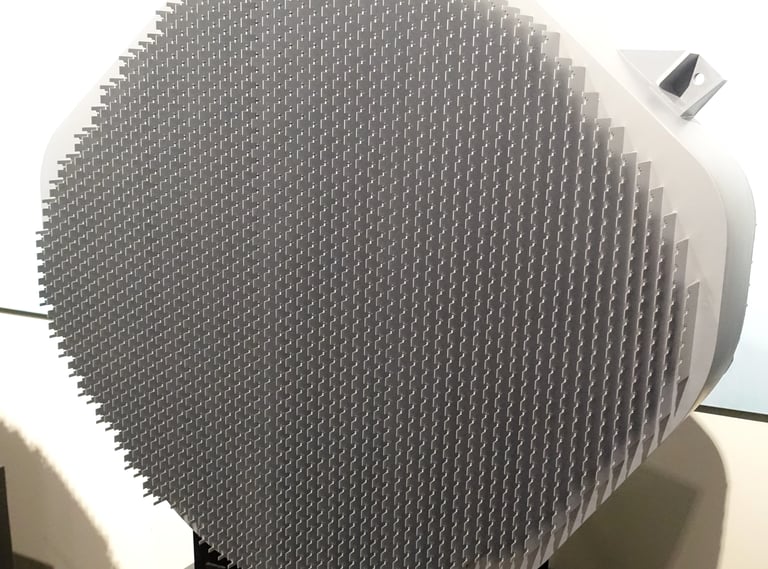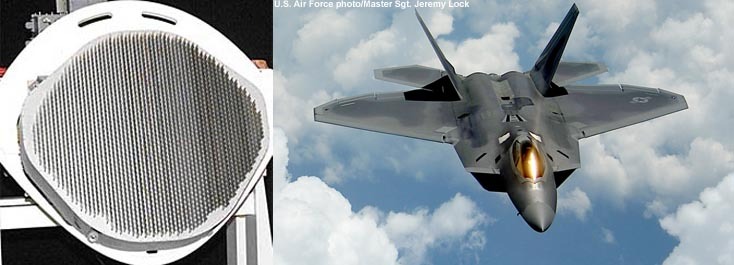APG-77's Various Modes
fact for 29/5/2021
FACTS
The AN/APG-77 is a multifunction Low probability of intercept radar installed on the F-22 Raptor fighter aircraft. It is solid-state, active electronically scanned array (AESA) radar. The APG-77(V) radar for the F-22 is based on the successful APG-66/68/80(V) family of fire control radars.
It is a multifunction solid-state, active electronically scanned array (AESA) Low probability of intercept radar installed on the F-22 Raptor. It provides 120° field of view in azimuth and elevation.


The active electronically scanned array (AESA) is a fixed, active array consisting of 2000+ transmit/receive modules module low-power X-band transmit or receive modules that are electronically scanned or "steered," with no mechanical movement, each about the size of a gum stick. The separate transmitter and receiver for each radiating element results in increased agility, low radar cross-section, and wide bandwidth(edited)
Its fast phase shifting and a lower level of energy is radiated by the side lobes, eliminating the spillover common to feed horn/reflector antennas. This makes the radar less detectable and reduces ground clutter. The APG-77(V) does not have a main processor of its own. Instead, two central integrated processors (CIPs), which can each process 700 million instructions per second with growth capacity up to 2,200 million, integrate the radar with other sensors and the electronic warfare systems on the F-22
Air to Air Modes


1)..Range while search(RWS)
RWS mode processing provides air-to-air, all-aspect target detection, even in heavy clutter. The radar displays synthetic video on a clutter-free scope when presenting airborne targets, even those flying close to the ground. Ground-moving targets are eliminated by selective filtering and logic. There is a Spotlight mode to scan a small, pilot-selected volume to facilitate the detection of a desired target at the earliest possible time.
2)..VELOCITY SEARCH WHILE RANGING (VSR).
This mode gives maximum detection-range performance against closing; nose-aspect targets out to 160 nautical miles in both uplook and downlook situations. Through advanced processing within the Advanced Pilotage System Program, an innovative Alert/Confirm mode is activated to achieve a low rate of false alarm, while extending the range capability of the radar beyond the RWS mode.
3) TRACK-WHILE-SCAN.
This mode was designed to help a pilot cope with numerically superior forces. To maximize situational awareness and firepower, TWS can track up to 10 targets. Target tracks are displayed for up to 13 seconds after a missed detection before the track file is terminated. This mode has proved effective in multi targeting situations.


4) SINGLE-TARGET TRACK (STT)
This mode can be entered from any of the air-to-air search modes by using the side-stick controller and throttle grip. It provides a dependable, accurate track, displaying target parameters and the tactical engagement geometry. The STT submode provides track data to support cueing for short-range and beyond-visual-range air-to-air missile shots. It also provides gun-sight envelope solutions for short-range gunnery modes.
5) SITUATIONAL AWARENESS MODE (SAM)
This provides the pilot with an interleaved search and track capability. SAM provides high-quality tracking on one or two targets while searching for other targets in an independent, pilot-selected scan volume. Track accuracy makes this mode ideal for accurate air-to-air missile cueing and all beyond-visual-range (BVR) target engagements.
6) TRACK RETENTION THROUGH THE NOTCH (TRTN).
This feature is automatically activated in the track phase for STT and SAM. It allows active tracking when the target is maneuvering into the same Doppler filter as main beam clutter and when the target amplitude is such that the radar can no longer distinguish the target from clutter. The radar will automatically "coast" for a few seconds, until the target emerges from the clutter region...
Advanced Strike Modes
a) ENHANCED REAL BEAM GROUND MAP (GM)
. This mode generates a map for navigation and target detection out to 80 nautical miles. It was enhanced with a monopulse mapping technique that sharpens map features for hard targets both off-boresight and on the nose. Both direct and offset weapons delivery are possible. A Freeze option stops radar emissions and allows the aircraft to approach the target radar-silent. An extended map mode provides a 4:1 resolution improvement and map expansion
b) DOPPLER BEAM SHARPENING (DBS). When a target of interest is displayed on the ground map at 10-, 20-, or 40-nautical-mile scale, DBS1 mode gives an accurate map of a selected area with an 8:1 azimuth resolution improvement. A resolution of 64:1 is possible with DBS2 mode. This mode gives off-boresight weapons the improved resolution needed for precise launch data. The Freeze option is also available.
c) SEA.
This will detect seaborne targets in medium and low sea-state clutter. It is similar to the GM mode, but the radar processor integrates more radar samples to produce a map better tailored for maritime surveillance. Slower scan rates and additional samples increase sea-target detection performance. The Freeze option is available.
d) FIXED TARGET TRACK (FTT)
This mode can automatically maintain an accurate track on a stationary target for fix-taking and weapons delivery. FTT is accessible from the GM, GM EXP, SEA, SEA EXP, and DBS modes. Slow-moving targets can be acquired from GM or SEA modes using FTT mode.(edited)
e) GROUND MOVING TARGET INDICATION (GMTI)
This detects moving targets such as cars, trucks, tanks, other military vehicles, ships, and taxiing aircraft on land or sea out to 40 nautical miles. GMTI mode can also be used to detect moving surface targets in high sea-states. The Freeze option is available.
f) GROUND MOVING TARGET TRACK (GMTT)..
This mode automatically maintains an accurate track on a moving vehicle (land or sea) for weapons delivery. It is available only from the GMTI mode. Moving targets detected in GMTI can be acquired and tracked using GMTT
g) BEACON (BCN)
In this mode, the radar detects a beacon transponder for fix-taking and air-to ground weapons delivery offset. It can also be used for tanker rendezvous. The Freeze option is available.


by - Exeter#3926 from discord
